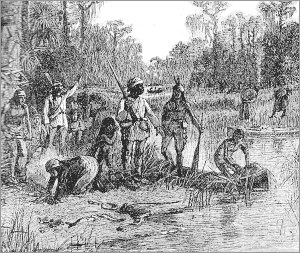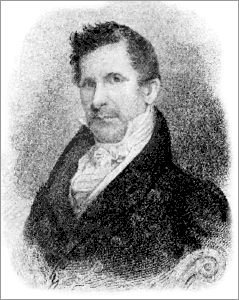| Home > Floripedia > Seminole Wars, Beginning of | |
Seminole Wars, Beginning of
A History of Florida1904
Reservation Troubles. The Indians were not satisfied with the lands given them, and would not keep within bounds. As more settlers came into the Territory, more land was wanted by the white people, and plans were made for removing the Indians to lands west of the Mississippi so that all of Florida should be open to white settlers. In 1832 a treaty was made with a number of chiefs by which it was agreed that certain of the chiefs with their agent and their negro interpreter, Abraham, should go to examine the western lands, and if they were satisfied, the Indians would all remove there.

The Seminoles in FloridaThe Western Lands. After examining the lands the chiefs said they were satisfied. But when they returned home, their people refused to go to the western lands. The Seminoles were runaways from the Creeks, and were not willing to go to the reservation where they and the Creeks would have to live together again. Another reason was that they did not want to go to a colder climate. Besides they had heard there was no "lightwood" on the reservation, and they did not see how they could get on without "lightwood." Even the chiefs who had said they were satisfied did not advise their people to consent to removal.
What reasons made it desirable to remove the Indians west of the Mississippi? Who examined the western lands? On what grounds did the tribes refuse to go?
Duval succeeded by Eaton. In 1834 Governor Duval's long administration came to an end, and General Jackson, then President, appointed General John Eaton governor of Florida. Eaton, like Jackson himself, was a native of North Carolina, and had gone to Tennessee to practice law. From Tennessee he had been sent to the United States Senate.

Governor EatonYou remember that when Jackson had marched into Florida, then a Spanish colony, to punish hostile Indians and other persons whom he suspected of aiding the enemies of our country, many persons had blamed him. He was especially blamed for capturing St. Marks and Pensacola, and for putting to death the two Englishmen, Arbuthnot and Ambrister. The matter was brought up in Congress, and Eaton was one of those appointed to examine into the facts. He was Jackson's friend through all, defending every act. He said that for many years he had known the talents and good qualities of Jackson, who had done nothing for which his country should blame him. He insisted that Jackson's conduct was justified by military necessities, and that he bad not been guilty of undue severity.
Who succeeded Duval? Tell of Eaton's life and achievements.
He was not superstitious as most of the Indians were. He was fearless, but not reckless. He was always kind to his wife and children, and it may have been his affection for them that made him merciful to other women and children. When he went on the war-path, he would say to his warriors: "Spare the women and children. It is not upon them we make war and draw the scalping knife; it is upon men; let us act like men."
Osceola's Treaty. At a meeting with General Thompson, the agent, to talk about the removal of the Indians, Osceola, who had then no right to speak in council as he was not a chief, sat by the old chief, Micanopy, and whispered to him what to say. General Thompson told the Indians that they should have no more money from the government. Osceola became very angry. He rose from his seat and said the Indians did not care if they never received another dollar from the "Great Father," as they called the President. He drew out his knife and stuck it into the table, crying out, "This is the only treaty I will ever make with the whites." From this time Osceola was the leader of the Indians.
What of his personal traits? The "Osceola Treaty" incident.
Trouble Brewing. When the agent reported to the government that the Indians were buying great quantities of powder, he was forbidden to sell them any more. This made them very angry. "Am I a negro? Am I a slave?" cried Osceola. "My skin is dark, but not black, I am all Indian, a Seminole!"
About this time he came often to General Thompson's headquarters at Fort King, behaving so insolently that the general had him imprisoned in the fort until he acknowledged himself wrong, and also said he was ready to leave the Territory. Soon after his release, he came back to the fort, bringing with him seventy warriors, all of whom, he said, were ready to obey the "Great Father." These warriors, after living on government rations for a while, disappeared into their swamps and hammocks, and soon news came that Osceola was on the warpath. It was then that Charley Emathla was killed.
General Thompson Ambushed. Osceola had not forgiven General Thompson for imprisoning him, and was determined to revenge himself. He lay in ambush several days near Fort King, waiting for his opportunity. One pleasant afternoon when General Thompson and Lieutenant Smith, not suspecting danger, were walking out some distance from the fort, the opportunity came. Osceola and his comrades, firing, killed both the general and the lieutenant. Then after killing the employes at the settler's store, and burning the building, they set off to join their comrades in the Big Wahoo Swamp on the Withlacoochee.
How was he punished for insolence? What deception was practiced by him? What revenge for his imprisonment did he have?
Source:
Excerpt from Part Two, Chapter Six, "Beginning of the Seminole War" A History of Florida, 1904. Next Section; Table of Contents.
| Home > Floripedia > Seminole Wars, Beginning of |
Exploring
Florida: A Social Studies Resource for Students and Teachers
Produced by the Florida Center for Instructional
Technology,
College of Education, University of South Florida © 2005.